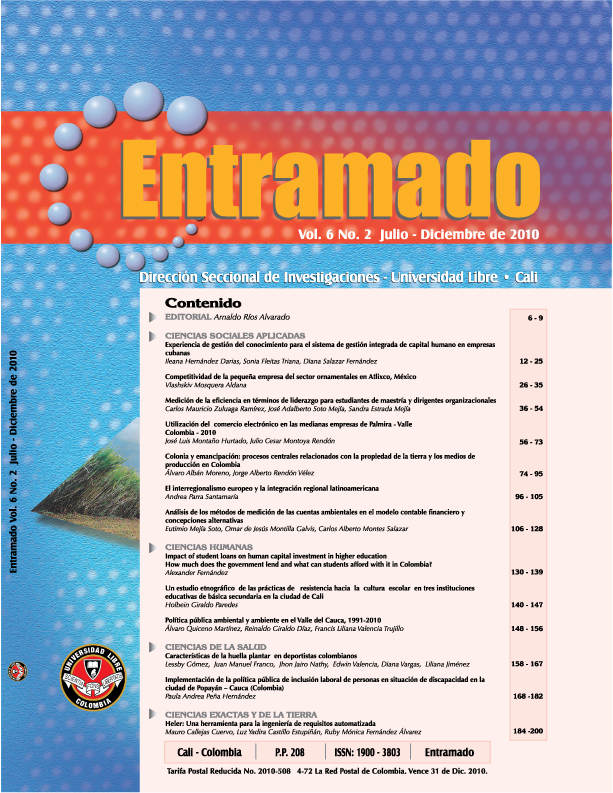Impacto de los prestamos estudiantiles en la inversion de capital humano en educacion superior ¿Cuánto presta el gobierno y a qué pueden tener acceso los estudiantes con esos préstamos en Colombia?
H ow much does the government lend and what can students afford with it in Colombia
Palabras clave:
Affordability, human capital theory, student loans, cost sharing, cost of education, higher education, subsidies, out of pocket cost, net costResumen
Student loan programs in Colombia have been in operation since 1953. In fact, this country was the first Latin American country to implement them. Nevertheless, this article argues that student loans through ICETEX are not directly connected to high quality accredited institutions; instead they reinforce technical or vocational education, especially in academic programs at private universities with low tuition fees. Additionally, talented students from poor backgrounds still have difficulty meeting the requirements for access to long- and medium-term loans despite the improvements that ICETEX, as a government agency in charge of student loan services, has implemented in recent years. The analysis is first presented by reviewing the human capital theory and the concepts of cost sharing and student loans. Next, we contextualize them, comparing the types and amounts of student loans with the actual cost of education in Colombia. The conclusions were drawn based on estimates of the maximum, minimum, and average amounts loaned through ICETEX, as compared to the actual cost of education. Affordability of higher education in Colombia was found to be much lower than in developed countries, and student loans are far from being enough to enable underprivileged students to gain access to high-quality accredited institutions in this country. The results are meant to motivate academics and those interested in the economics of higher education to expand the scope of studies that promote a more efficient social balance in the strategy for student loans in this country.
Descargas
Referencias
2. BARR, N. Economics of the welfare state. 4th edition Oxford: Oxford University Press, 2003. chapter 14, p.321-345.
3. BECKER, G.S. Human Capital: A Theoretical and Empirical Analysis with Special Reference to Education. New York : National Bureau of Economic Research, 1964.
4. PATRINOS, H. The privatization of higher education in Colombia: Effects on quality and Equity. In : Higher Education v 20 (1990); p. 161-173 Netherlands : Kluwer Academic Publishers.
5. SCHULTZ, T.W. Investment in human capital. In: American Economic Review, v 51 (1961); p. 1-17.
6. TEIXEIRA, Pedro; JOHNSTONE, Bruce; ROSA, María Joao and VOSSENSTEYN Hans. Cost-Sharing and Accessibility in Higher Education: A Fairer Deal?, Dordrecht: Springer: Introduction and Conclusion by Editors; Chapters 2 and 3 by Jongbloed and Johnstone. 2006
7. USHER, A. and CERVENAN, A. Global Higher Education Rankings 2005. Toronto, ON. : Educational Policy Institute.2005
8. WOODHALL, M. Student Loans: Potential, Problems, and Lessons from International Experience In: JHEA/RESA Vol. 2, No. 2 (2204) p.37–51 Boston College & Council for the Development of Social Science Research in Africa.
9. WOODHALL, M. Student loans in developing countries: feasibility, experience and prospects for reform. In: Higher Education v 23 (1992); p. 347-356. Netherlands : Kluwer Academic Publishers.
10. WOODHALL, M. . Lending for learning: Designing a student loan programme for developing countries. London: Commonwealth Secretariat. Africa, 2004.
11. World Bank. Accessibility and Affordability of Tertiary Education, Murakami Y. and Blom A.in Brazil, Colombia, Mexico and Peru within a Global Context1. World Bank Washington D.C.2008.
1. CANa Comite Nacional de Acreditacion en Colombia. Sistema Nacional de Acrediticacion en Colombia.(2010) (Retrieved on Nov 10th 2010) http://www.cna.gov.co/1741/article-186365.html
2. CANb Comite Nacional de Acreditacion en Colombia. Lista de Universidades con Acreditacion de Alta Calidad. (2010)(Retrieved on Nov 10th 2010) http://www.cna.gov.co/1741/articles-188924_recurso_3.pdf
3. ICETEX Instituto Colombiano de Credito Educativo y Estudios en el Exterior. Creditos Educativos. (2010)(Retrieved on Nove 10th 2010) http://www.icetex.gov.co/portal/Default.aspx?tabid=151
4. ICETEX Instituto Colombiano de Credito Educativo y Estudios en el Exterior. Creditos a Mediano Plazo. (2010)(Retrieved on Nove 10th 2010) http://www.icetex.gov.co/portal/Default.aspx?tabid=824
5. ICETEX Instituto Colombiano de Credito Educativo y Estudios en el Exterior. Creditos a Largo Plazo ACESS. (2010)(Retrieved on Nove 10th 2010) http://www.icetex.gov.co/portal/Default.aspx?tabid=704
6. SINIESa Sistema Nacional de Educación Superior en Colombia. Numero de Instituciones de Educacion Superior. (2010) (Retrieved on Nov 10th 2010) http://snies.mineducacion.gov.co/men/consultas/ContenedorRepConsultas.jsp?nombreCategoria=NUMIES&titulo=N%FAmero%20de%20Instituciones%20de%20Educaci%F3n%20Superior
7. SINIESb Sistema Nacional de Educación Superior en Colombia. Número de Estudiantes matriculados. (2010) (Retrieved on Nov 10th 2010) http://snies.mineducacion.gov.co/men/consultas/ContenedorRepConsultas.jsp?nombreCategoria=NUMERO_EST&titulo=N%FAmero%20de%20estudiantes%20matriculados
8. SINIESc Sistema Nacional de Educación Superior en Colombia. Numero de programas acreditados según tipo de acreditación. (2010) (Retrieved on Nov 10th 2010) http://snies.mineducacion.gov.co/men/consultas/ContenedorRepConsultas.jsp
UNIANDES Universidad de los Andes. Valores de Matricula Periodo 2011-1 . (2010) (Retrieved on Nov 10th 2010) https://matriculas.uniandes.edu.co/matriculas/servlet/Controller?action=generic&pagina=valores.jsp&p
10. UNIMINUTO Corporación Universitaria Minuto de Dios. Precios 2011. (2010) (Retrieved on Nov 10th 2010) http://portal.uniminuto.edu/index.php/admisiones/precios-2011.html
11. World Bank, GDP Ranking PPP based. World Bank, Washington, DC. 2010. (Retrieved on Nov 10th 2010) http://data.worldbank.org/data-catalog/GDP-PPP-based-table, http://www.tradingeconomics.com/Economics/GDP-Per-Capita-PPP.aspx?Symbol=COP


